November 28, 2006
Kagan on more forces in Iraq
Frederick Kagan writes in the Standard:
"The Washington Post recently proclaimed: "The United States and its allies in Iraq would need at least 500,000 and perhaps more than 1 million troops" to bring order to the country. Incoming House majority leader Steny Hoyer declared: "As a practical matter, there are no troops to increase with." Neither of these statements is true. The persistence of these myths forecloses serious consideration of the only option likely to bring peace to Iraq."
Kagan goes on to lay out his case, which is more than one could say for the previous attempt, by the other Kagan, Robert, and Bill Kristol, which said only, without further elaboration, "Those who claim that it is impossible to send 50,000 more troops to Iraq, because the troops don't exist, are wrong. The troops do exist."
In his piece, as in previous efforts, F. Kagan goes on to explain his belief that the extra troops can be found by a combination of lengthening troop rotations and accelerating the training of soldiers in the pipeline. One can stipulate to this theoretical possibility, however, and still have some serious concerns with Mr. Kagan's other assumptions.
Kagan stipulates that the only U.S. troops that are immediately available would have to by delaying the return dates on 20,000 soldiers now in theatre when the next block of 20,000 trained replacements arrive. Accelerating the training on the next block would bring in the remainder of the 50,000 troops he seeks some months later. The only problem with this is that at that point the troops whose return you delayed would by then have run out their extension, along with the next tranche behind them -- unless their return was delayed as well. The US cycles home 25,000 soldiers from Iraq every two months. To get that initial boost, what Kagan is really saying, then, is the current Iraq tour of duty would need to be lengthened for the foreseeable future from 12 months up to at least 14. That'll go over well (as Kagan concedes).
Even that only achieves half of Kagan's 50,000 increase, however: the rest, he says, comes from accelerating (really, reducing) training times. He rightly concedes that this effect would take some time to achieve; in other words, what the Kagan plan amounts to is those 25,000 extra troops now, and an additional 25,000 troops a couple months later.
A statistical study suggests this is unlikely to work in practice. Never mind that at the end of Kagan's reinforcement period, we'd be talking 210,000 Americans and 10,000 allied soldiers in Iraq, significantly more than there were during the Iraq invasion. Never mind that because the "surge" would not be fully realized or operational for at least two months from the word "go," during which conditions in Iraq could well worsen. (Could one still even call it that when one is now talking an operation that would take months to assemble, and months more to "fix" Baghdad, before then as Kagan says moving on to Anbar for Phase Two? We're talking at least a year of a larger troop level to prepare for and achieve all that.)
The problem, as noted here before, is that while there may be some statistical correlation between changes in the number of troops in Iraq and civilian violence levels there, there has been no correlation at all between total U.S. force levels and civilian violence, by any measure one can find. What that means is that there is some evidence that smaller (20-25,000 man) increases would dampen the violence temporarily, that the violence would find its new equilibrium at the higher deployment level.
This might change if one was talking about immediately "flooding the zone" with 50,000 troops at once, but Kagan's not doing that, basically conceding between the lines that it would be impossible. But the statistics indicate any slower, steadier rate of increase seems unlikely to have much in the way of tangible effect: after all, U.S. forces have surged by 20,000 twice before already with no lasting impact on the situation.
The other questionable Kagan assumption relates to the support of Iraqi forces. His historical peacekeeping ratios are accurate: low intensity legionary work is, was, always has been, basically a numbers game, but he cheats a little when he counts Iraqi forces into the mix. Normally in this kind of peacekeeping calculus, unless the locally raised troops have a Gurkha-style loyalty to you, you don't do this, for reasons that should be obvious in Iraq. The vast majority of those "trained Iraqi forces" are either in the Shiite- or Kurdish-dominated units. If you deploy the Kurds in Baghdad or the Shiites in Kirkuk, they will likely end up contributing to the violence, and through the usual outrages start up new hotspots in previously safe areas; but if you deploy them in their home territories, they're not contributing nearly as much to the equation.
This is, of course, the logic behind "Vietnamization," letting the local troops handle rear area security in areas where the population doesn't hate them, freeing up U.S. troops for the trouble spots. Fine. But that means you can either count the number of U.S. troops vs. the "trouble spot" population in your ratio, or the number of troops, loyal and disloyal, vs. the entire population of the country, when you're doing that reliable old 1 soldier-to-100 citizens ratio for successful peacekeeping. Taking "all troops" vs "some of the population" is cheating.
Iraq has 27 million people, and the old math suggests that you needed 270,000 trained peacekeepers (local or foreign) to really keep some kind of lid on that size of population. Which is, of course, what Shinseki said, and what the U.S. didn't do. By disdaining foreign military assistance, by taking their time on Iraqi military training, by disbanding the Iraqi army wholesale, by never having more than 180,000 foreign troops in country for the first couple years, that lid came right off.
The old math also suggests that once you allow that to happen, and you need to put that lid back on, then you need a higher ratio of occupiers-to-occupied to quell the insurrection (Kagan's 1-to-40 is one estimate). Again, the standard way to do this has been to count the whole country for your population base,and include the native allies, or, alternatively, just count the trouble spot population and only count your own troops. Kagan cheats a little by using the trouble spot population, but also counting Iraqi troops: effectively discounting large portions of the country as already 'cleared' in coming up with his 1-to-40 thumbnailer.
How many troops are needed to have a positive effect in Iraq now? It's hard to say: more than there are at present, certainly. A back of the envelope estimate based on historical precedents would be that 27 million citizens requires 270,000 troops. Cutting Kagan's estimate of reliable Iraqi soldiers in half and counting 50,000 trained locals against that means 220,000 western forces: about 60,000 more than there are at present.
That is corroborated by the apparent real world requirement for another division (20,000+) in both Baghdad and Anbar at present.
Numbers suggest that if the U.S. did choose to "reoccupy" Iraq (cause that's basically what you're talking about at this point, invading and taking over the country a second time), they'd probably need about 60,000 more soldiers on top of what they have at present. Again, it's just mathematics so take it with large salt blocks, but I think that would be the kind of levels that would be required to execute any kind of new, winning, kinetic strategy at this point. Anything less (which means, basically, anything that's realistically possible) would seem a half-measure.
That does not mean that another strategy, involving other elements besides raw troop strength and reconquest, might not still achieve success (as the strategy chose to define it); just that a troops-only, "Shock and Awe 2" strategy would seem to require more troops than the U.S. has readily to hand.
By the way, do the Weekly Standard editors require at least one non sequitur per column? In this piece, there's at least one new moment that makes you go "Huh": "Indeed, previous successful operations even in Baghdad did not require such high force ratios." Kagan, of course, doesn't elaborate on what those successes were, but one presumes those would be those successful operations, that because they were so successful, mean that 60,000 more troops are now needed, right? (The one operation he mentions, Forward Together, failed, he concedes, because, surprise, the U.S. didn't have enough troops to pull it off.)
November 22, 2006
November 21, 2006
So where did it go off the rails
This page has long said (starting in 2002) that the United States occupation of Iraq would be a low-odds Hail Mary proposition. It's been further stated here that things were already not going well before the Bremer takeover in May of 2003 and got significantly worse almost immediately thereafter, due to the rushed and phony "election" schedule and the disbandment of the Iraqi army.
I think history will back these conclusions up. The only other inflection point to find then, is where things went completely, irrecoverably wrong, to the point where American aims were no longer within the realm of the feasible.
I think the consensus will come that that point was the first 2-3 months of 2006. The statistics I've been idly citing the last few posts would seem to indicate that's when the internecine violence really ramped up, to the point at which national institutions, such as the army, began approaching the verge of ceasing to function altogether. I think that there were a couple reasons for this, both political and military, that happened in close proximity to each other:
1. First was the Dec. 15, 2005 election, which solidified Shia-Kurd control of the Iraq government. It was wrongly interpreted, I believe, at the time, as a vote for national unity, but the parties were so clearly already demarcated on sectarian lines that it really became something more like a census. The only party that had representation from more than one group, Allawi's National List, only received 8 per cent of the vote; the Sunni, of course, largely boycotted the event.
2. Immediately following, of course, came January's unprecedently rapid, and largely unnoted, drawdown of American troop strength in the country, with 24,000 U.S. and 2,000 Coalition forces leaving in the space of a few weeks. Much of this had been the recovery of a surge in troop strength that had been sent to last through the October constitutional vote and the December election. The larger number was not meant as sustainable, but it was certainly a sudden change in the ground truth at a bad time.
3. The effect of this was multiplied by the ensuing long and unconstitutional delay in the formation of the new Maliki government (Maliki would not take office until May, amid peaking violence), due to the inability of the Iraqi political parties to find a compromise candidate suitable to all of them. Iraqi government was essentially paralysed for five months.
4. All this left the paralysed government and U.S. forces without an effective ability to respond to the devastating al-Askari Mosque bombing on Feb. 22, or the violence that followed. Well, that's not quite true, because even though the Askari bombing was in all likelihood committed by Al Qaeda in Iraq, it served to significantly strengthen the position of the Shia and Kurdish leadership within their own communities, as well.
This doesn't mean, of course, that events prior to December, 2005 had no impact... the two 2004 battles of Fallujah, to take an example were a big contributor to both Sunni alienation and a growing Shia resentment for Sunnis. Given what had gone before, the election result itself seems almost pre-ordained, in fact. The fact that the government took so long to form, in the face of strict constitutional provisions limiting the deliberation times, is a reflection of American inability by this point to influence the political process decisively anymore, but that impotence, too, had seeds much farther back.
The only decision point that could have changed in the last year was the U.S. extending their expanded military presence even longer, until the government had seated itself. The equivalent of another division in Iraq might have offered some more options when the crisis-at-the-worst-possible-time (Al-Askari) came: certainly the military thinning-out immediately upon the conclusion of a safe election, even before the ballot counts had been ratified and with a country waking up to a firm political split on ethnic lines, seems a little unseemly now. The fact that it apparently wasn't possible to contemplate a further redeployment delay is a testament to how stretched the U.S. military now is. It is the uncomfortable reality, I fear, that will prove to have dropped the curtain on this ill-advised foreign adventure.
November 17, 2006
Responses to troop numbers posts
Some of the feedback I received from readers on the troop numbers posts, below the fold.
An anonymous emailer writes:
I'm not a military analyst, but I was working at the US embassy in Baghdad during the period under discussion, took a keen interest in the military picture, and have a reaction to the discussion.
I think there is a fairly simple explanation for the two statistical observations you are trying to explain - the troop increase/violence decrease in two periods, November 2004 - February 2005 and September - November 2005.
Both these periods saw the relatively rare phenomenon of sustained and significant Coalition offensive operations, in both cases to "set the conditions" for electoral events (first election in January 2005, constitutional referendum in October 2005, election for permanent government in December 2005). Of course the troop plus-ups were specifically for these offensive initiatives, but it's the kinetic operations themselves that were the point.
When on offense, with the exception of unusual cases like Fallujah II in November 2004 against a comparatively prepared defense, the Coalition is likely to suffer fewer casualties and also suppress the level of violence because offensive action disrupts enemy activities, kills and captures enemy personnel, and generally puts pressure on the enemy, making it much harder for the enemy to attack Coalition forces at times or places of his choosing.
To simplify it a bit, it's what you do with the troops, not how many are in-theater.
If one were to examine violence levels in specific areas of Iraq to see correlations with Coalition offensive operations, I have no doubt the link would be clear. There aren't many Coalition offensives, unfortunately, but probably enough to make the fairly obvious linkage clear. Hell, there doesn't even have to be an "offensive" - in some case just taking SOME action will have an effect. I still recall that an immediate effect of the hasty blockade thrown up around Fallujah as a result of the contractor incident in April 2004 was a dramatic decrease in car bombs in Baghdad. I was still in the US at that point, and I seem to recall street vendors in Baghdad making this astute intel observation to western reporters - that's how obvious it was.
There's no non-military solution to the Sunni insurgency in Iraq. But the military and civilian leadership has convinced themselves there's no military solution, so while overall success is still likely in the long run, it'll be a longer run than it had to be.
Another writes:
Although this is harder to quantify, it would also be worth seeing whether there's any change in ROE or procedures during periods such as before elections. We have put more troops in theater at such times, but other changes - such as less stringent rules of engagement, or more attention to certain groups or individuals - might account for a difference in enemy successes and failures at such times.
I also notice that you're graphing number of coalition casualties. Does anything different happen to the numbers if you graph number of attacks instead of total casualties? What if you include Iraqi Army/Police. or Iraqi civilian casualties? There might be a tendency to focus attacks on our troops when more are available - or there might be an opposite tendency, a feeling that troops are too strong and attacking civilians would be preferable.
In a similar vein, Jared writes:
Why are you using coalition troop fatalities as the metric for violence in Iraq? Why not use civilian deaths or total violent incidents? Lots of reasons to do that, not the least of which you already pointed out in that the delta in troop numbers is small. I would also argue that the number of troop deaths is pretty small compared to total number of attacks (either against troops or civilians) which possibly makes it less useful.
Have you considered also adding in total security force size by including the growing numbers of Iraqi forces?
(BruceR: see my latest post for my reasons not to use attacks or Iraqi security force stats.)
Charles M. writes:
You may be aware that there is a literature in economics regarding the impact of the number of US policemen on domestic crime. The most striking aspect of this research is the following correlation: cities with more policemen (per capita) have more crime. I've seen several honors students beach themselves on the rock of trying to explain the result with stories of how policemen cause crime, but there is of course is a more elegant explanation, namely that the number of policemen is not randomly determined. Cities where crime is more endemic are likely to have larger police forces in an effort to contain said crime, while cities with little endemic crime will choose to have smaller police forces.
If US troops are likewise being allocated in response to seasonal or endemic sources of violence, we would expect to see the same correlation, even if additional troops reduce the violence that would have otherwise occurred. Note that this does not undercut the possibility that higher troop levels encourage violence ... it merely says that a positive correlation cannot distinguish between the two explanations.
Is there then any way to answer the underlying question? Given the limited number of observations and time-series nature of the present data, probably not. One might, however, be able to expand the data from a time series (monthly observations of Iraq) to a panel data set (monthly observations of cities in Iraq). This would not address the endogenous troops concern detailed above, but it does introduce a higher probability of significant results. (It also opens up the whack-a-mole critique, but I believe that's a distinct concern.) To fully address the endogenous troops concern, one would want some story of troops being sent to cities for reasons that are distinct from anticipation of violence. A whimsical example would be if the US were periodically trying to threaten Syria/Iran and flooding border towns with more troops to do so. Unfortunately, I know of no such pseudo-experiments on this margin.
(BruceR: Agreed, correlation is not causation. In the case of the Iraqi civilian stats in my latest post, however, it's difficult to see the mechanism whereby increases in violence would cause decreases in Coalition troop strength, so one might reasonably assume any causation would work in the reverse.)
John C. writes:
My point in a similar article I wrote at drumwaster,.com is that the violence follows it's own pattern, losely associated with our elections (both primary and other) and news cycles. Since Ramadan is celebrated according to the lunar calendar, it progresses around the Gregorian calendar, doesn't it?
(BruceR: this is a shortcoming of the method I should have noted: what I did try to note that even the fall violent period is probably partly a religious and partly a climatic cycle.)
Finally, there is a fairly lengthy post here I should also respond to:
All the raw data was drawn from the latest Brookings Institution Iraq index, here, and the icasualties.org site, here. I've also in the latest post, imposed some trendline bars and R-squared values, partly because this is the first time I could see any trends that were obviously significant. As to month-lags, I agree, which is why I did all the rate-of-change scattergraphs with a subsequent-month ("2mo") set of points to see if that kind of change would be evident. Except in the case identified in the most recent post below, I haven't found any correlation yet on that basis.
Effects of troop numbers in Iraq, part 3
See previous entries here and here.
An obvious criticism of the method used below to estimate the effect of troop increases in Iraq is the choice of Coalition fatalities or casualties as the measure of violence. Even in the best of circumstances, all it is giving us is a measure of the degree of anti-Western violence, which is not the only component of violence in Iraq by any stretch. Aggregate violence in Iraq could conceivably rise or fall independently of the rate with which Western troops are being attacked, under a number of possible scenarios. If the problem to be solved is achieving a stable Iraq, then violence against Coalition troops may not be a particularly useful performance measure.
Measures of violence against Iraqi security forces is not particularly useful either; in addition to seasonal variation, one would need to control for the numbers of security forces available, which has grown rapidly, at least on paper, over the last few years. Weighting the relative value of different kinds of security forces is also an issue, as is the reliability of (possibly self-serving) estimates of the numbers of Iraqis on duty.
Which leaves measures of violence against civilians as what we really want to achieve here. But as most people are aware, this has been a subject of much controversy, particularly over recent estimates made in the Lancet medical journal. Iraq Body Count keeps a monthly tally of media-reported non-military deaths, but it is generally presumed to be undercounting by a significant measure. Iraqi health ministry estimates and morgue counts have also been criticized as potentially undercounting the scope of the national violence problem. There is also the question of who is being counted... insurgents, police, victims of crime, excess deaths due to declining quality of life, etc.?
On the other hand, it was hard to me personally to accept that one could not find *any* correlation between the presence of Western soldiers in Iraq and violence statistics, so I tried a couple of the available publicly statistical sets out, and finally found one that provided a strong correlation between force presence and violence. Unfortunately, it's a rather limited set for other reasons, but it does produce at least one additional interesting conclusion to add to what I have written on this topic thus far.
The data set referred to here is the UN Iraq Assistance Mission's tally of deaths due to violence, which they have provided from January 2006 on. Used as well by the Brookings Institution, this statistic does not differentiate between violent deaths due to crime or other causes. It is based on Iraqi health ministry and morgue tallies, and excludes all Iraqi military and security personnel. Its estimate of 19,925 deaths between Jan. 1 and Aug. 31 of this year is significantly higher than the Iraq Body Count figures for the same period, but hardly implausible.
Putting this limited data set on a scattergraph with American troop levels for the same time period shows a significant negative correlation between total troop levels and civilian deaths. It also shows a significant correlation between increases in troop levels and decreases in civilian deaths a month later, as you can see below:
Coalition Force levels (x) vs UNAMI Civilian Fatalities per month (y), Jan-Aug 2006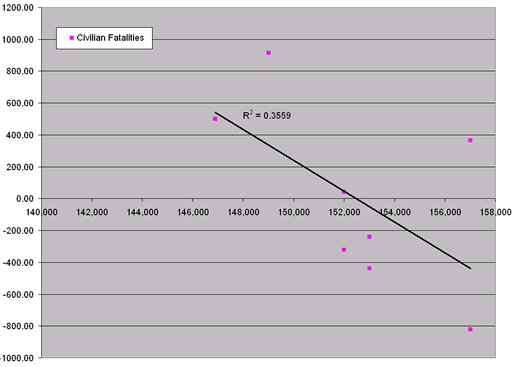
In the scatter-graph above, the total Coalition force level is shown on the horizontal scale, with the points indicating the monthly tallies of civilian fatalities as indicated by the UNAMI tally. There is evidence, given a very limited data set, for a close-to-linear relation in this eight-month period between civilian fatalities and force strength. Troop decreases occurred in parallel with increases in the violent death rate, and vice versa.
Changes in Coalition Force levels (x) vs changes in UNAMI Civilian Fatality tallies in the same and subsequent months (y), Jan-Aug 2006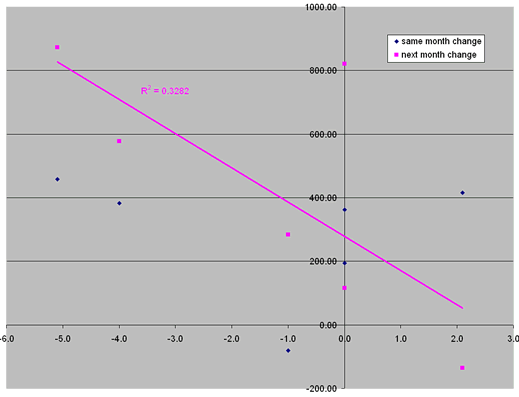
This scattergraph shows the effect of changing troop levels has had. Generally there is no effect discernible in the same month as an increase or decrease, but there is a significant and potentially linear relationship between changes in force level and civilian casualties the month after.
Now, again, this is a very limited data set. But let's try to interpret what we can. What's been happening to Coalition force levels in 2006? Here's another graph that may be useful, even if it's otherwise as dodgy as hell, statistically:
Seasonally Adjusted Iraq Civilian Fatality Variations from Mean (two methods combined)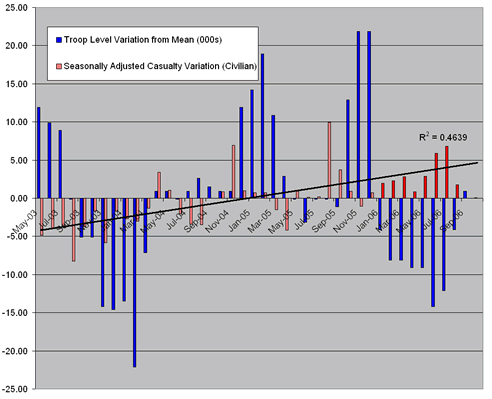
This graph does something that probably never should be done by a statistician with any reputation worth preserving. Prior to using the UNAMI count, the Brookings Institution figures for Iraqi civilian casualties relied on a modified version of the Iraq Body Count estimates, derived by removing all security force fatalities, and all morgue reports due to the potential for double counting, then multiplied by a factor of 1.75 to offset undercounting. That number, Brookings reported, corresponded to roughly half the UNAMI figure (because the UNAMI figures include deaths from crime as well, supposedly) for comparable months.
So, because the date range for the UNAMI figures is so short, you could try to extend its conclusions by taking the Brookings "modified IBC" number, multiplying by a further factor of 2 to bring it into parity, subtracting a seasonal variation figure based on the average of fatalities in the same month, and end up with the graph you see here. (Modified IBC numbers are in pink; UNAMI numbers are in red.)
When you consider all the bias introduced by this manipulation, on top of the known concerns about the original IBC tally method, you get a number that wouldn't seem to be worth much . So the fairly obvious and significant linear trend in Iraqi violence over time that this graph seems to indicate may be plausible but the individual monthly totals would not appear to be valuable for any month-by-month analysis: the implicit error bars on those modified IBC figures, and their tenuous relationship with the UNAMI numbers, are simply too big. (The correlation found with the UNAMI numbers does not extend backward, either: when you do a scattergraph comparing the combined civilian death numbers to troop levels across the whole period you're back to an apparently random, non-correlating distribution again.)
That said, I think this graph does demonstrate at least some basis for the common conventional wisdom that the violent death rate of Iraqi civilians was higher in 2006 than in 2005 or before. And look at those troop levels: the largest drop in the entire occupation period came in January, 2006: minus 26,000, a 14% drop in the size of the occupation force in one month, followed by further declines until June. AFter that, force increases in July and August seem to have had a positive effect on the violence level.
This sudden drop in force strength, three times the size of any other decrease, was relatively uncommented upon at the time: I certainly didn't note it as significant until now. One has to wonder, given the demonstrated correlations previously in this post between civilian violence and lowered troop levels since, whether this may have been a contributing factor to the 2006 violence. It is even possible history may conclude that in the early months of 2006, it was the act of American forces withdrawing too much, too fast, that lifted the lid on Iraqi-on-Iraqi violence.
All that said, what could one conclude would be the result of another American surge deployment, up to 20,000 or so (a 12% increase, or 180,000 total), for about six months, in the absence of any other changes in force posture or strategy. Statistically, this would be the most likely prediction:
1) Coalition force fatalities would be expected to increase proportionately with the number of troops in theatre (a 5-15% increase in total wounded and fatalities per month; perhaps 30-50 additional KIAs and 300-500 WIA over a six month period).'
2) There would probably be an initial, apparently very promising decrease in the number of Iraqi civilians being killed with more troops on the ground able to exert a greater degree of local control. This effect would diminish over time, however;
3) If January of 2005 was any indication, any rapid subsequent decrease in force levels, violence would likely return to Iraq with a vengeance.
This is, it should be noted the same old Vietnam rat trap: needing more and more troops to do less and less. It appears that raising troop levels incrementally (20,000 or less) again might delay the crisis in Iraq, but it cannot by itself result in the kind of transformative change required to forestall it completely. (Effects of a troop increase in the 30-50,000 range, if such a thing were possible, could still be of a different order of effectiveness, however.)
Salutin on Borat: sounds about right
I think Rick Salutin gets it pretty much correct in his assessment of the Borat phenomenon today, but I'd take it a little further.
Borat's popularity is very much a function of the American (and Canadian) public saying, "to hell with foreigners, and their countries; they're all asses anyway." It's making fun of the other, so you can disengage from any moral imperative to treat them fairly. (Salutin is right that the movie's success has nothing to do with Americans making coming to terms with their own closed-mindedness, as some would pretend: the majority of the movie's fans simply want to laugh at the Other without consequences. Borat gives them that opportunity.)
The success of a movie like Borat is an indicator of a growing American public desire for neo-isolationism. Jingopunditry's current advocation of a more aerial warfighting strategy (the "more rubble, less trouble" meme) is another.
November 16, 2006
Iraq casualties part 2: counting in US wounded
Lots of emails today, many with very good points. See the previous entry that they refer to here. If time and available data permits, I'll try and continue this line of inquiry.
One point that a correspondent raised was why not use Coalition wounded and killed, instead of just KIA figures, which is what Stuntz used? There were a couple reasons for this:
1) There's no accurate publicly available measure for non-US coalition WIAs in Iraq: the best one could do would be to count US killed and wounded, plus non-US killed, and assume coalition wounded numbers (which if comparable in proportion would be about 5-10% of the 21,400 US wounded, or 1-2,000 soldiers) did not skew one's numbers too much;
2) US monthly WIA figures include both wounded soldiers who are returned to their units within 72 hours, and those that are evacuated from theatre. This could lead to soldiers in high-intensity environments being counted in the wounded column multiple times.
Still, if one can deal with those caveats, there's no problem providing similar graphs for all KIA casualties plus US wounded in the same format. The chart below shows the variation from the mean in thousands of the Coalition forces (in blue) against variation from the mean in US wounded plus all killed per 10,000 occupiers per month (corrected for seasonal variation), in red. As in the post below, blue bars above the zero-line indicate periods of troop strength. Red lines above the zero-line indicate periods of higher-than-average Coalition casualties. If more troops lead to fewer casualties, and vice versa, red bars up top should be matched by blue bars below, and vice versa:
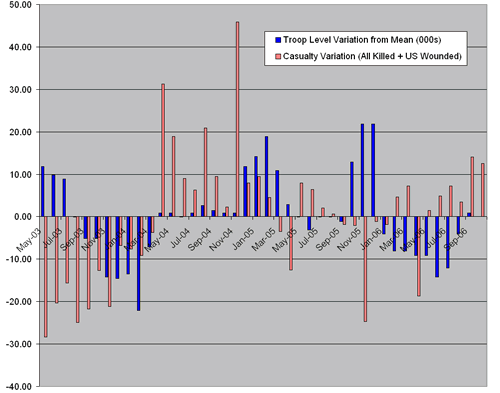
Looking at this graph, as with the last one, one can see it tells something of a narrative of occupation: in some cases it shows more troops leading to a decrease in Coalition fatalities, and in others not. In late 2003, the degree of violence was on the increase, in a period of relative undermanning, but in 2004 after the First Battle of Fallujah, the anti-Coalition violence was dropping even while troop levels stayed fairly steady, up until the Second Fallujah period in November 2004. That was followed by a 20,000-strong US surge into the theatre, which, it is true, could be interpreted as being simultaneous with a calm on the violence, but then again in mid 2005 one can see violence levels decreasing even though troop levels stayed at a steady state. The second surge at the end of 2005 was too short to have a clearly discernible effect. Most recently, one sees a period where Coalition troop levels are rising again, but violence against them is increasing simultaneously.
The scattergraphs, when US WIAs are counted, don't appear to offer any more of a strong correlation than when just killed were counted. Here is the comparison of casualty levels (y-axis) vs troop levels (x-axis):
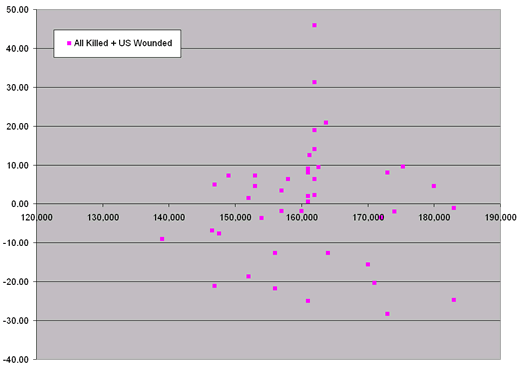
Here is the comparison of changes in anti-Coalition violence level (y-axis) vs changes in troop level (x), with one set of points showing the same (1-month) comparison, and the other showing the change in violence levels 2 months after the change in troop levels. The troops = peace thesis, if true, would be represented on this graph as a clear line sloping down left to right through the zero point, with points in the high left and low right quadrants:
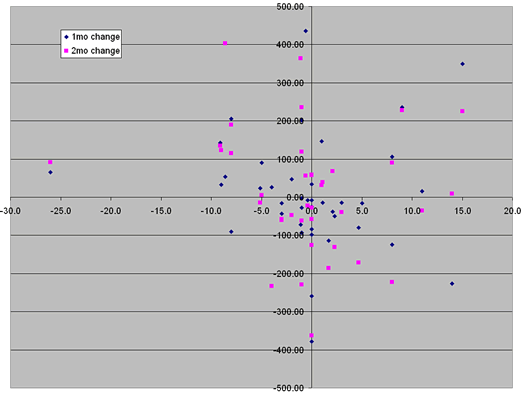
It appears that regardless of one uses this new measure of Coalition wounded and killed, or just the KIA number from before, as one's measure of Iraq violence, it is still no more clear-cut whether adding more troops can produce more security, at least based on the Iraq record so far. Another interesting question is whether there is an impact from increases and decreases in troop levels on the violence being done to Iraqis. Obviously this is fraught with problems given the many opinions out there on what the correct way to measure Iraqi casualties is, but it's something I'd still like to examine further.
Must-read of the month: Nir Rosen on Iraq
This is an amazing, revelatory article about the Iraq situation.
November 15, 2006
Ralph Peters: an 'I was wrong' would be nice
The increasingly unhinged Ralph Peters, today:
With political correctness permeating our government and even the upper echelons of the military, we never tried the one technique that has a solid track record of defeating insurgents if applied consistently: the rigorous imposition of public order.
Peters, eight months ago:
In place of the civil war that elements in our media declared, I saw full streets, open shops, traffic jams, donkey carts, Muslim holiday flags - and children everywhere, waving as our Humvees passed. Even the clouds of dust we stirred up didn't deter them. And the presence of children in the streets is the best possible indicator of a low threat level.
Troop numbers in Afghanistan v Iraq: are different prescriptions required?
A reader of the last few posts could ask why a proposal by Bill Clinton to increase Afghan force levels by 8,000 meets with some approval and a proposed increase by John McCain of Iraq force levels by 20,000 does not.
Leaving aside all the other obvious differences between the situations in the two nations, an argument for this view can still be made solely for statistical reasons. Simply put, the McCain proposal is repeating something that's already been tried, whereas the Clinton proposal is breaking new ground.
In Iraq, coalition forces there are at pretty much their historic average for troop numbers in country: 161,000. The McCain proposal to increase this by 20,000 only brings the number back to the 183,000 peak it's already been at twice before, with no apparent lasting impact on violence levels nation-wide. (The old line about insanity being doing the same exact thing and expecting different results may be worth considering in this context.)
In Afghanistan, NATO force levels, now slightly above 30,000, are at their historic high. There have never been as many Western troops dedicated to the Afghan problem as there have been since early this fall. Clinton's proposal is, that in light of recent developments that indicate trouble ahead in the southern and eastern NATO regional command areas in 2007, that this number should be increased even further, up as much as 40,000.
Also worth noting in this context is that troop levels, compared to the size of the population, are significantly lower in Afghanistan than in Iraq. Iraq-style troop levels, or anything remotely close to them, have never been tried in Afghanistan until now. Even the Clinton proposal would only bring troop densities up to 3 coalition soldiers per 1000 inhabitants... still less than half of the Iraq average (see graph below):
Coalition soldiers per 1000 inhabitants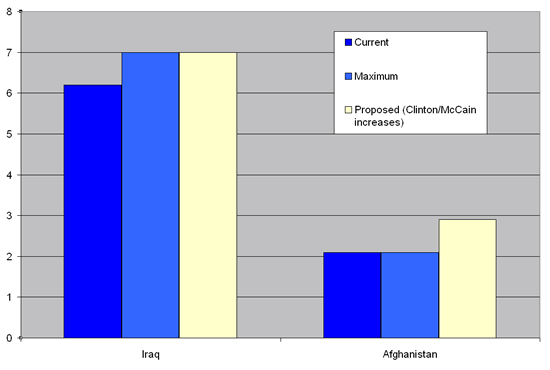
The argument of the numbers indicates that, in the absence of other changes in doctrine and strategy, another 20,000 soldiers in Iraq is unlikely to accomplish anything previous similarly-sized attempts already have. To really put the thesis that troop levels are the main issue in these occupation efforts to the test, one would have to increase the number of American soldiers on the ground in Iraq by a much larger number, perhaps as many as the 50,000 advocated by William Kristol here, for something in excess of six months.
There are obvious questions about whether the United States has the force generation capacity to do this any time soon. Certainly, any significant increase in Iraq troop levels will rule out Clinton's recommended increase for Afghanistan. It's something of an either-or between reinforcing the two occupation efforts as much as proponents of either course have proposed.
This is a pity, because if the logic of those calling for troop level increases in Iraq has any validity, it will have even more validity in Afghanistan, where for a much smaller commitment of troops, one could potentially "flood the zone" with occupiers more effectively than one could ever do in Iraq. It's even possible that one extra reinforced brigade in Afghanistan next year would have as much influence on that country as committing two new divisions would in Iraq... even if those divisions existed to send. The risk here is, that by undermanning Afghanistan in 2007, one could end up significantly degrading the security situation in that country without having any significant offsetting influence in Iraq.
This is the same risk that is warned against, in the context of a single-country insurgency, by Andrew Krepinevich with his writings on an "inkblot strategy:" address the problem insufficiently on a country-wide basis, and you will lose all to the insurgents: focus on one province, or one city, and work out, and you have a better chance to succeed. It may be possible that policy makers in the U.S. and NATO should start envisioning Iraq-Afghanistan as a combined problem, where Afghanistan is currently the best location in the theatre for future inkblotting.
November 14, 2006
Effects of troop numbers in Iraq
Back to the Stuntz paper for a moment, because it poses an interesting military-statistical question:
Consider these data: Between November 2004 and February 2005, according to the Brookings Institution's Iraq Index, the number of coalition soldiers in Iraq rose by 18,000. In that time, the number of Iraqi civilians killed fell by two-thirds, and the number of American troops wounded fell by three-fourths. The soldiers were soon pulled out; by the summer of 2005, American and Iraqi casualties rose again. Later that year, the same thing happened again. Between September and November of 2005, another 23,000 soldiers were deployed in Iraq; once again, both Iraqi and American casualties fell. In the early months of 2006, the number of soldiers fell again, and casualties spiraled up.
The picture is clear: More soldiers mean less violence, hence fewer casualties.
This is a graphical representation of what Stuntz is talking about. The blue bars are the variation in historical troop totals from the occupation-long mean of 161,000. The red bars are the variation from the mean in coalition fatalities by hostile causes in that month (34.1 per 100,000 troops is the average). If Stuntz's thesis had borne out up until now, whenever the blue bar is above the zero line (greater than average violence), the red bar should presumably be below it (fewer than average troops), and vice versa (ie, more troops equals less violence, less troops equals more violence):
Coalition hostile death rates per 100,000 soldiers per month compared to Coalition force level variations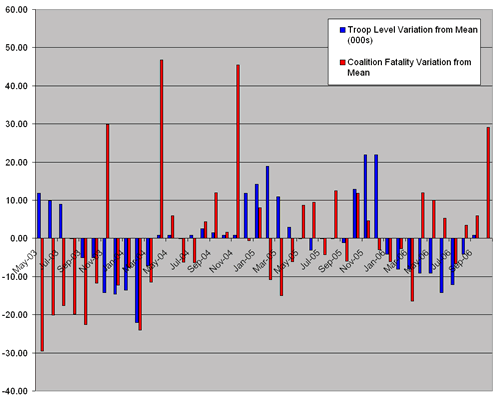
Looking at the blue bars, the graph shows that, as Stuntz says, we've basically had two "surges" of US and allied forces into Iraq since the occupation began -- January-February 05, and again in November-December 05 -- but it appears possibly with more mixed results than he's indicating above. In the early 2005 case, there at first does appear to have been a correlation between increased troop presence and a reduced level of violence in the spring of 2005 (even if Stuntz is cherrypicking his months a little in the quote above to maximize the effect); but in the second instance, the statistical evidence for any correlation seems less pronounced.
The correlation between periods where there was a reduced number of troops and an increase in violence is less clear: there are several months where the blue and red bars are both below the line, indicating a period where low violence and low troop levels coincided. There are even a couple points where an increase in coalition troop levels was simultaneous with an increase in violence (spring/04 and again in fall/06).
Correlation is not causation, of course. One obvious competing hypothesis would be that Iraq violence follows its own rhythms, and coalition troop levels have exerted a fairly minor effect. In fact, Iraq coalition fatalities seem to have developed a "double peak" annual cycle, with higher than average fatalities in the late fall, around Ramadan, and a second, smaller peak in the April period, with calmer periods in between in the winter and summer. There are obvious climatic and religious reasons this would be the case. The chart below shows average Coalition hostile fatalities by month, which illustrates the curve better:
Monthly averages of Coalition hostile fatalities since start of occupation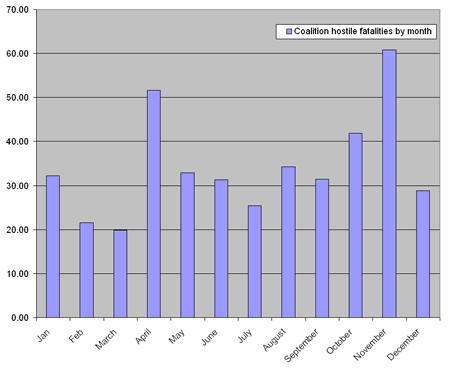
To extrapolate a calming effect due to troop increases, one could try subtracting out this seasonal variation in violence rates. The following graph attempts to correct in this fashion. In this graph, a red bar below the line in May, for instance, indicates a "calmer than average May." Just as with the previous graph like this, if increased troops lead to greater calm, and vice versa, the the blue and red bars should be mostly on opposite sides of the zero-line below:
Seasonally-corrected Coalition hostile death rates per 100,000 soldiers per month, compared to Coalition force level variations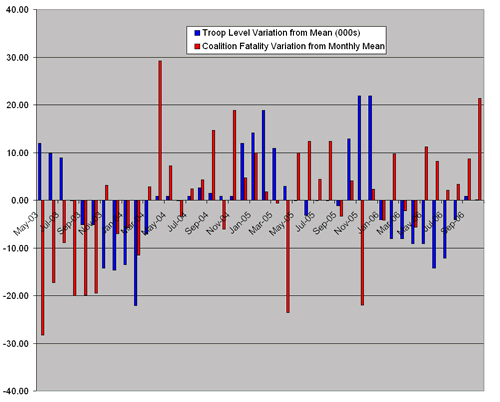
But again, it's not particularly clear cut. Some periods of the Iraq occupation seem to fit the Stuntz hypothesis, but others do not. Also note that the spring 2005 calming Stuntz suggested above seems a much less viable conclusion in this context: the relativized violence levels are not only higher than in the same season in other years, right in the period of a U.S. surge, but there is also no obvious difference in the relativized level of violence between the surge period and the summer immediately following, where troop numbers were back down close to the average level again. In short, early-to-mid-2005 by this measure was a more violent-than usual period for Coalition troops in Iraq apparently no matter how many troops were coming in or leaving.
It's not necessarily counterintuitive that more troops could increase violence levels, either. If the occupying troops are on the balance an irritant to the society being occupied, increasing their numbers could conceivably serve to increase the irritation. More troops also makes for more targets, an obvious shortcoming of the comparative method I'm using here, even if Coalition combat fatalities is a preferable measure of violent levels otherwise: I've attempted to correct a little by using Coalition violent fatalities per 100,000 rather than the simple total, throughout.
There simply may not be enough data to establish a statistical relation between troop levels and violence. Or there may not be one at all. The following scattergraph shows violence levels, defined by violent deaths of Coalition soldiers per 100,000 per month, relative to the average of violent deaths for that month (y-axis), directly against what the Coalition combat troop levels were in the same months (x-axis). If Stuntz's point is to hold, there would be a discernable downward sloping curve evident, presumably, as more troops in a given month resulted in less violence. Judge for yourself:
Total Coalition force levels (x) vs change in seasonally-corrected Coalition hostile deaths per month (y)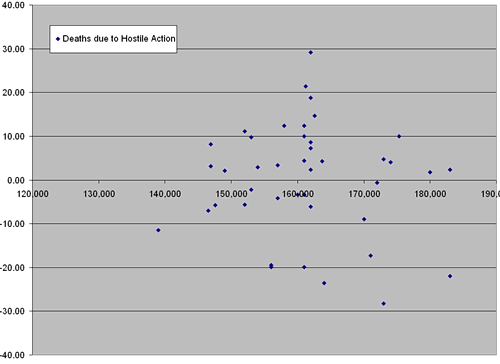
Finally, a supporter of the Stuntz thesis might argue that it was the effect of changing troop levels that would have the impact of calming or heightening tensions in an occupied country, not just the total: the surge or withdrawal would then have a delayed impact, one or more months after the troops arrive or depart. So here's a scattergraph of that, with the change in troop level in each month (x axis) compared to the change in violent Coalition fatalities in the same month (blue), and one month later (pink) on the y-axis. Again, for the Stuntz thesis to be valid, one should expect to discern a downward sloping curve, with the majority of points in the upper left or lower right quadrants here. Here, I don't believe there's a discernable correlation, but judge for yourself:
Changes in force levels (000s) (x) vs change in seasonally-corrected Coalition hostile death rates per month after 1 and 2 months (y)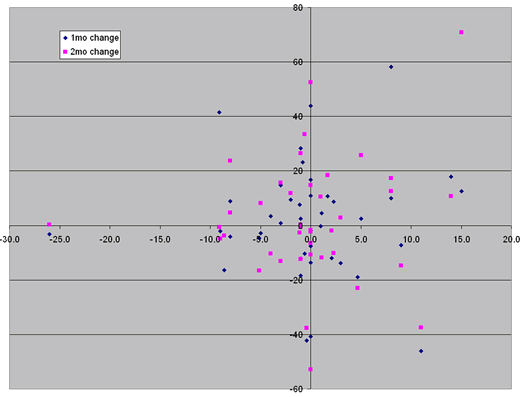
It should be obvious this is a fairly important question. If it can be established increased troop levels have been producing a positive effect on the security situation, that not only means that there is some hope for future stabilization through a troop increase, but that American forces have had and are having a net positive effect on Iraqi security levels now. If, on the other hand, no correlation between troop levels and violence levels can be established, the logical conclusion is American troops have been contributing very little to stabilizing the Iraqi situation, in any numbers. Regrettably for supporters of the Stuntz argument, given the statistical data to date, the latter seems the stronger conclusion.
See also Henley and Djerejian.
(Coalition force numbers from the Brookings Institution. Fatality numbers from iCasualties.org.)
Update: the other conclusion that one could draw from this is that no effects are discernible because the variation in troop numbers is so small, only plus/minus 20,000 or so. It's fair to say that the two 20,000 size surges in 2005 appear to have had no lasting effect on violence rates... therefore the prospects that another 20,000 increase (c. 180,000 Coalition forces combined) would achieve anything lasting seem dim. This would support the argument that only a major Western military intervention, on a scale that has not so far been seriously contemplated (190,000 troops or more in country, at least 30,000 more than there are now) would be required to accomplish anything different.
UPDATE: I continue this line of analysis, this time counting US wounded as well, here.
November 13, 2006
Yes, but what's its error-to-fact ratio
I suppose it was inevitable, but the only thing Uncyclopedia seems to prove is that an understanding of what's funny remains a relatively rare commodity in the general public, at least compared to most forms of lay factual knowledge.
This, sadly, despite much wise advice from the founders such as, "Please, for the love of Sophia, stop pasting in articles from Wikipedia. Yes. We are aware that golf balls are white. We do not care. We care about their mating and nesting habits. Be funny."
Double down?
Here's what one can conclude from the new Bill Stuntz piece, "Doubling Down in Iraq."
Stuntz does not play blackjack. Erm, that is all.
I believe the term Stuntz should have been looking for in that headline was "call and raise," or "go all in," since what he's really talking about in his conclusion is analogizing Iraq to a poker hand, where psychology is a major factor.
Doubling down, on the other hand, refers to blackjack, specifically the offer that the house normally gives players to double their bet once two cards are dealt.
Because no bluffing or mental play is involved in blackjack -- it's strictly a probabilistic bet against the house -- doubling down is only done *by a good player* when the face-up cards show a player advantage, most commonly when the house is showing a 2 through 6, meaning the player is more likely to win the hand. It is in no way a good play simply because a given hand isn't going particularly well so far for you.
If one wanted to analogize blackjack doubling down to a real-world strategy, it would be "take maximum advantage whenever things are going your way." Which, even if generally true, is not particularly relevant advice in the case of Iraq.
Glenn Reynolds evidently doesn't play much 21, either. Pity: good game, when you know what you're doing.
The non-barking Persian pooch
The dog that didn't bark in Afghanistan, one that is never commented upon, but is probably worth considering in the Iraqi rethinking context now, is the neutral-to-positive impact Iran has had on stability in that country.
It's fair to say that Iran retains a significant unrealized capacity to muck things up for NATO if it felt the need. The fact it hasn't has to be attributed to a) a preference for the elected Karzai government over the alternatives on offer; and/or b) the implicit promise that a NATO/UN/World Bank/EU occupation, vice a US-led one, carries that the territory in question will not be used as a springboard for aggressive forays into or over Iranian territory. NATO simply isn't scary to Iranians. One suspects an American offer of a non-aggression pact would have helped calm things in Iraq for the same reasons. Still could, maybe.
The Baker Commission may be drawing the same conclusion.
Afghan news
It has been now one month since the most recent Canadian fatalities in Afghanistan (Oct. 14). As mentioned in previous posts this follows historic patterns of fighting in that country's many wars dying down through the November-February winter period. (It may not be Mark Steyn's "brutal Afghan winter," but the truth is it does seem to always calm things down a titch.)
Bill Clinton says another 8,000 troops are needed. That's about what I'd have said, too. Right now the combat situation is basically two brigade groups (NATO Bde and the US 4 BCT), along with Afghan auxiliaries, fighting three distinct insurgent regional commands (see posts passim). A third brigade-size formation would give NATO commanders at all levels the strategic depth to weather the coming 2007 insurgent offensive, and continue to progress on the development front in the south and east. Without further reinforcement, the potential risk is retrograde action on development in security in either or both the RC-South (NATO) or RC-East (US) areas in March-October 2007. The good news is, unlike Iraq where the insurgency hasn't been taking winter breaks, NATO should now be able to count on three and a half months of relative calm, knock on wood, before crunch time. It's fair to say it's not often in wars you see the threat coming that far off.
I think I'm about the last person to sink into a "schools painted" sort of wishful thinking when Western military interventions are involved, but the simple fact is rebuilding in Afghanistan has been more marked than Iraq because there was so much more to rebuild. In Iraq the challenge has been restoring electrical power to a capital that up until March 2003 was the center of a functioning civil society... in Kabul it's been getting electrical power at all, after decades of civil war and Talibanist medievalism. So this is probably a useful piece for war opponents to read. Highlights:
*80% of the population has access to basic health care, up from less than 10% in 2002;
*$11 million a month into development projects selected by elected Afghan village development councils: 7,500 projects completed so far;
*6 million Afghan children in school, up from 1 million in 2001, of which 2.2 million are girls, the highest number of girls receiving education in Afghan history (NB: but still only a third of the potential total, according to HRW);
*individual income figures 70% higher than in 2001;
*greater than 10% annualized economic growth for the last five years;
*1,000 schools opened in 2006 alone;
*45,000 trained teachers, including 15,000 women.
The only way I think one can objectively read figures like this is that, all other things being equal, the average Afghan really is significantly better off than he/she was five years ago. It's got to get a lot better, still, of course, before it's likely to stick. And the only alternative on offer is a return to nihilism and destruction.
(It's far from rosy, of course. There is a significant drought disaster ongoing that needs to be addressed. UNICEF is pleading for support; a story I note that was taken up by neither the Toronto Star nor the Globe and Mail last week.)
Finally, a note on the 3,700 Afghan fatalities story in the Canadian papers today. It's probably worth observing that not only is the UN's number fairly reliable, given how closely it's tracking the Associated Press aggregated count this year, but that somewhere surely it'll have been broken down further into insurgent casualties, Afghan military and police casualties, and civilian casualties -- figures that were apparently unavailable at Canadian papers' press time yesterday. The best thing we can say is that the current HRW estimate is that "over a thousand" of those deaths are civilians, meaning over 2,000 of those deaths were of combatants, enemy or friendly. As for the civilians, there can be no doubt after reading the links above, that the major international agencies involved consider the insurgency to be responsible for far more of the civilian death toll than NATO or U.S. forces were this year, too. (Another data point that the reporter might have used for comparison is that the peak of 600 attacks per month this year was roughly a fifth of the current (3,000 per month) Iraqi monthly average.)
November 09, 2006
Afstan: a tale of two polls
Two polls out today. From USA Today:
"Despite a raging pro-Taliban insurgency, the people of Afghanistan say they are optimistic about the future, satisfied with their young democracy and rank security low on their list of everyday concerns, according to a survey out today.
"In what it is billing as the widest opinion poll conducted in Afghanistan, the non-profit, San Francisco-based Asia Foundation surveyed 6,226 Afghans 18 and older in person in 32 of the country's 34 provinces over the summer."
Meanwhile, from the Toronto Star:
"More than half of Canadians wanted to see their troops pulled from Afghanistan before the scheduled end of their mandate in 2009, and almost as many did not think Canada's mission to the violence-plagued country will be successful, a new poll suggests."
UPDATE: More on Canadian Afghan polls, here.
November 07, 2006
Canadian TV worth watching (if you're a kid, anyway)
I should probably drop a brief note of praise for the excellent Canadian animated series, Class of the Titans. Yeah, it's kid stuff, but it's exceptionally well done kid stuff: it's the best thing out of Canadian TV stalwart Nelvana studio I've seen in a while, and is definitely a big step up for Vancouver's Studio B Productions, as well.
(If nothing else in this modernized take on Greek mythology, you have to appreciate a series that titles its episode retelling the Myrmidon myth as "They Might be G.I. Ants.")
There's actually some pretty good Canadian youth-oriented animation around these days, generally coming out of the whole Corus Entertainment conglomerate (which owns Nelvana as well as two of the three Canadian English-language kids networks available in the Toronto market (Treehouse and YTV) and half of Teletoon, which airs Class of the Titans. I'd also include Carl Squared, Delilah and Julius, and for an even younger set, Franklin the Turtle and Backyardigans.
Fibonacci and proliferation
As opposed to the previous entry, this screed by the once reliable Joe Katzman is purest alarmism. From the previous article referred to in today's text:
"Fibonacci's sequence lives on today in the nightmare form of nuclear proliferation, and all current indications point to the conclusion that nothing of consequence will be done to halt the relentless addition of its sums."
The classic Fibonacci sequence is, of course, 1, 1, 2, 3, 5, 8, 13, 22, 35...
If you take the number of nuclear powers in each decade, not counting those who dismantled their programs like South Africa and Kazakhstan, and counting from the date of the first nuclear test* one gets:
2 (1940s), 3 (1950s), 5, 7, 7, 8, 9 (now)...
Not quite Fibonacci, is it?
Okay, but Katzman's point is that the rate of proliferation is increasing over time. Well, let's look at the years between the same 9 nuclear nations joining the club, which if it proliferation is accelerating, should be becoming shorter and shorter, something of a "reverse Fibonacci". So what are the intervals between nuclear tests (starting with four years between Trinity and the first Soviet test)?
4, 3, 8, 4, 10, 5, 19, 8...
Hey, let's put that on a graph, compared with an inverse Fibonacci (using 100/F):
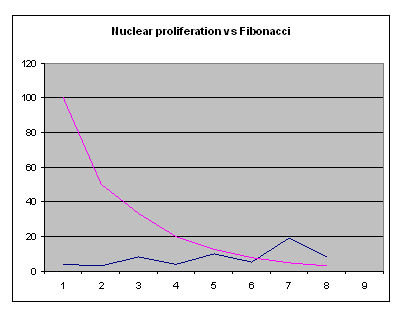
As you can see, the interval between new nuclear tests has actually been steadily increasing: the basic opposite of a Fibonacci progression. If one were to be strictly mathematical about it, one would predict the next nuclear power joining the club somewhere between 2015 and 2030.
Now look, Pakistan's breaking a 19-year history of global nuclear nonproliferation and joining the nuclear club in 1998 was certainly a blow to efforts in this regard, and A.Q. Khan didn't make things any better. But Katzman's argument really boils down to: in 1998 there was one country I don't trust with nukes, and now there's two, and some day Iran will be three. This of course, ignores that the category of "countries we don't trust" has altered greatly over time. And the rate of change that remains after you exclude the currently trustworthy countries has too few data points to have anything to do with any kind of predictive mathematics.
No doubt, more always needs to be done on nonproliferation, which would probably be helped if the U.S. voiced stronger support for international control efforts, by the way. But the fact remains if we want to predict the future mathematically from the past, which Katzman is saying he thinks he can do by citing Fibonacci, there's no doubt the curve has historically been running in the opposite direction (thankfully).
On the basis of the above alarmism, Katzman makes a falsifiable prediction (conveniently on American election day, I might add... boo!): "10-100 million dead [in the Middle East] within the next 2 decades," by which he means an Israeli-Muslim nuclear exchange in that time period. Events will bear him out, and if this blog is still around in some version in 2026, tune back in for my calling him out. I certainly hope and pray he's profoundly wrong.
But here's my own falsifiable prediction, based purely on the mathematical sequence above: if present mathematical trends in the rate of nuclear proliferation continue, in 2026 there will be no more than 11 states with nuclear weapons in the world: two more than today. So I guess that means, stay tuned.
*Using the 1979 Vela incident, considered a possible nuclear test, for Israel, and last month's possibly failed test for North Korea.
Michael Yon on Afstan: a caveat
Michael Yon, who is not a stupid man by any means, does go out on the limb a little here:
"Mark this on your calendar: Spring of 2007 will be a bloodbath in Afghanistan for NATO forces. Our British, Canadian, Australian, Dutch, and other allies will be slaughtered in Afghanistan if they dare step off base in the southern provinces, and nobody is screaming at the tops of their media-lungs about the impending disaster. I would not be surprised to see a NATO base overrun in Afghanistan in 2007 with all the soldiers killed or captured. And when it happens, how many will claim they had no idea it was so bad and blame the media for failing to raise the alarm? Here it is: WARNING! Troops in Afghanistan are facing slaughter in 2007!"
If I were Yon, I'd be at least as concerned about the U.S. forces from 10th Mountain Division in RC-East. I'm not sure why he gives them a pass, given that they're the ones actually on the Waziristan border, across from all those tribesmen who just signed the truce with Pakistan. Not only would an American base be a potentially more lucrative target politically, but the terrain could be seen as somewhat more conducive to the massing of larger forces, as well. It's certainly a reasonable assessment that there will be some more large-scale insurgent attack attempts in Afghanistan next spring, but it seems unlikely they'll be confined only to RC-South, as Yon suggests above.
UPDATE: I think Sean Maloney basically has it right, although I think talking about Al Qaeda's unwillingness to negotiate overstates the Al Qaeda power over the Taliban a little (if the Karzai government wants to attempt again to open up a back channel to their internal insurgency, we shouldn't be dogmatically opposed to that) and the reference to the Toronto bomb plot as a bona fide Al Qaeda-driven op seems rather ahead of the known facts, so far.
November 03, 2006
Fish bubbles?
Instapundit cites approvingly:
Facts pop up once in a while like fish bubbles on a quiet lake—hundreds of cars burned on a relatively calm night, at least a hundred every night all year long, 2500 policemen injured since January 2006—and disappear without consequences...
What does this sentence even mean? What are injured cops and burnt cars if they're not consequences? Did no one own the cars? Did the cops not know they were injured?
There's all kinds of consequences to large-scale rioting in any country. Only a deluded observer separated by an ocean could conclude otherwise, simply because they haven't appeared in her local newspaper yet. The only "quiet lake" here is the writer's empty mind.
For a tonic to this kind of idiocy, look here.
Captured Iraq documents: always fun, fun, fun
It's always fun, fun, fun to watch bloggers with no intelligence training pull a Cheney and sort through documents they find on the Internet, trying still one more time to tie Saddam Hussein to the Sept. 11 attacks. The Captain's Quarters has been very good for this sort of thing lately.
This is a classic example. The short story: an Iraqi intelligence source of Afghan descent told his handler that an Afghan diplomat named Dastani said that he (Dastani) had been told while in Iran that there was or had been a liaison connection between the Iraqi government and Osama Bin Laden (to whit, they had "expressed cooperation between themselves"), and Dastani thought the Americans shared this belief.
Captain's Quarters duly reports the truth obvious to the fevered mind: that because an unidentified Iranian had told the Afghan diplomat his belief that Bin Laden and Iraq were working together, therefore that must be true. That basically breaks just about every rule in any logic textbook you can find, but never mind.
The memo is garden variety intel chatter. By itself, it's completely meaningless. At best it gives a real intel operator some more evidence to base his or her assessment of the source's reliability and access, and tells us the diplomat Dastani was in Iran recently. This would then lead, in a responsible intelligence environment, to further queries... was Dastani really in Iran? Why was he in Iran? Who had he been talking to? And so on.
It's not enough information by itself to hang anything on, but it could conceivably, with further substantiation, support at least four intelligence assessments I could see the Iraqis considering making:
1. Unidentified Iranian elements (government? opposition? who knows?) were pushing the story (true? not true? no idea), to anyone who would listen, that the Iraqis and Bin Laden are in bed together, possibly in an effort to get some more U.S. bombing love headed Saddam Hussein's way;
2. The unidentified Iranian elements were pushing the same story sotto voce via the diplomat to the Taliban government, possibly to convince them that bin Laden was too hot to handle or doing deals without their knowledge with another obvious bad guy, perhaps because those Iranian elements wanted to see the Taliban disavow bin Laden;
3. The beleaguered Afghan government (or bin Laden himself) was aware that source "11002" had a conduit to Iraqi intelligence and was using the backchannel after Sept. 11 to try to communicate to the Iraqi leader the argument that they were all in this together now, possibly to encourage the Iraqis to support Afghanistan or Al Qaeda in whatever came next, or at least not to oppose them.
4. The American government was attempting to isolate the Taliban diplomatically by pushing information of an Iraq-al Qaeda connection via diplomatic or intelligence means to the unidentified Iranians, who had then related it to Dahstani.
None of these theses would be particularly surprising, if true, of course. It would certainly have been interesting to see what, if any, evidence had been shown to Mr. Dastani by his unidentified sources to see if there was any substantiation at all for his stated belief. But this one intrep by itself is open to such wide interpretation that it is useless by itself.
This is another classic. The short story: the Palestinian PFLP-GC made an offer of a 500-man military unit to the Iraqi government on March 25, 2003, five days after the bombing started. This, to the Captain, shows evidence "Saddam regime actively coordinated with Palestinian terrorists in the PFLP-GC as well as Hamas and Islamic Jihad."
What it shows, of course, besides the inerrant Palestinian tendency to back the wrong side in just about anything, is the wonder of bureaucracy in wartime. The Iraqi government official's minute approving the offer is dated March 31, six days after it was received.*
Just as a reminder, here was the Flit battle map from April 1, the day after the Iraqis agreed to let the Palestinians lend them a hand.
Now, it's probably fair to say Taha Yassin Ramadan (or as we'll always fondly remember him now, the Ten of Diamonds) can be excused for getting behind in his mail that week, having things on his mind like his imminent escape, that and the likely prospect of a smart bomb coming through the window, and all. I'm sure when he gets sentenced along with Saddam this Sunday, he'll be thinking, if only he'd seen that note about those 500 crazy Palestinians a little earlier, it might have changed everything.
What does Captain's Quarters take from it? It's wondrous, really. Because the PFLP-GC proposed to travel through Syria to get to Iraq, and because Syria has "run" Islamic Jihad and Hamas (not really true, but not entirely wrong, so let's let that one go), therefore Iraq must have been allied with Islamic Jihad and Hamas for years previously!
Wow. Okay, where to start?
The PFLP-GC (not the PFLP, that's different, even if the Captain doesn't know why) is a Syrian-backed militant group, that much is true. Led by Ahmed Jibril, they're based in Syria, and they do act at the Syrian government's behest, pretty much. Iin the days when Yasir Arafat sometimes would go against Syrian interests, the Syrians touted Jibril as their more pliable alternative Palestinian hero-figure. They draw their personnel from the Palestinian refugee populations in Syria and Lebanon. They haven't engaged in active terrorist ops on Israeli soil in well over a decade, though. They retain operational ties with Hezbollah, and the two groups have engaged in joint military operations in south Lebanon, recently -- they're probably best thought of these days as a sort of Sunni Palestinian auxiliary to the Shiite Hezbollah. So it's fair to say that the Syrians made or supported an offer of deniable military support to an Iraq government in its last days by one of their more reliable paramilitaries -- or at least recognized they'd be unable to stop this particular group from offering to help and so assented to their crossing the border.
Of course, Jibril, possibly the old-guard Palestinian resistance leader with the most military training, is no idiot, either. There's no evidence the promised soldiers would ever leave their camps in Lebanon: all we know for sure is Jibril made an effort, two weeks before Baghdad fell, to walk into the Iraqi consulate in Damascus with a pitch. His PFLP-GC, because it has had no real role in the Palestinian struggle since before Oslo, was in decline even in 2003. The loss of the organization's military leader, Jibril's son Jihad Ahmed Jibril, to a car bomb in 2002 had pretty much sucked any remaining life out of Jibril Sr's organization. The most likely scenario is he or his Syrian superiors could see the end was near for Saddam anyway, and Jibril was making the offer in part out of a self-promotional instinct, possibly to trumpet to his Palestinian support base later ("hey, we were on the road when Baghdad fell... donate generously to the PFLP-GC").
But in any case, we already knew Hussein was financially supporting the families of Palestinian "martyrs" prior to the Iraq War. Iraqi support of terrorist acts against Israel, a support shared by numerous Middle Eastern regimes through the years, was long-standing and undisputed. What has never been confirmed is that he was partial to any of the aims or ambitions of Al Qaeda, and hence posed any kind of immediate danger to the United States in 2003.
Jibril, it should be noted, is a fairly secular terrorist, quasi-Marxist in his ideology, not particularly extremist in his religion, one who has been around the Middle East since 1968... exactly the kind of "terrorist" that Hussein would have been ideologically comfortable with. (Jibril has no confirmed operational ties with Al Qaeda.) Without question, we know Hussein was a danger to Israelis and their interests: but that was never suggested as a reason for the war, making this translated "intelligence find" completely off-point... whatever the Captain's point might actually have been. The collective self-delusion involved among far-right jingobloggers, at this point, seems almost unfathomable.
*The probable reason for the long wait time has to in part be due to the unreliability of the Iraq government's secure communications with its embassies by this point in the war. Practically the only reliable secure means they had left would have been courier, given the likelihood of being bombed on the road and other uncertainties this would not have been a pleasant or easy task to fulfill. The Iraqi response was likely sent back the same way... one wonders if Jibril even received his reply before Baghdad fell.
"endearingly macho" -- Mark Steyn
"wonderfully detailed analysis" -- John Allemang, Globe and Mail
"unusually candid" -- Tom Ricks, Foreignpolicy.com
May 2010
April 2010
March 2010
February 2010
January 2010
December 2009
November 2009
October 2009
September 2009
August 2009
July 2009
News:
The Globe and Mail
The Star
The Wash. Post
Opinion:
TNR
Slate
Washington Monthly
Rants:
Canadians
Penny
Janes
Cosh
The Hound
Coyne
Wells
Farrell, etc.
Steyn
Levant
Afghanistan
The Torch
Abu M.
Bill & Bob
Ghosts of Alex
Registan
Jari
Ink Spots
Ackerman
Kings
FRI
Embedded
Milnews.ca
Can-AFG
The Capt.
Etc.
TMLutas
Sullivan
Marshall
Kaus
Lileks
Reynolds
Welch
Farber
The Shark
Breen
Henley
Electrolite
Samizdata
Slotman
Simberg
Northrup
Bryant
Yglesias
Cole
Drum
Clients/Employers
(Past and Present):
U of T
Cdn. Forces
CG Magazine
LRC
Adrenaline Vault
